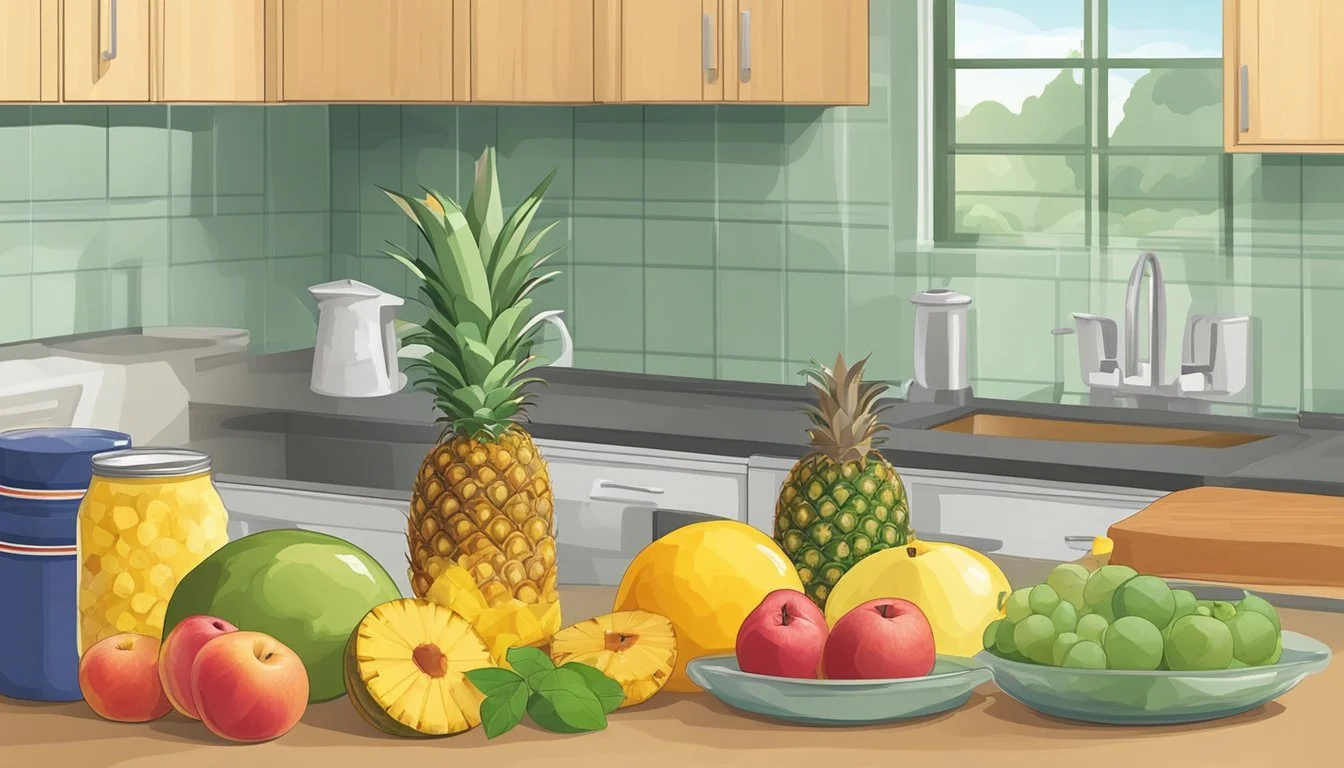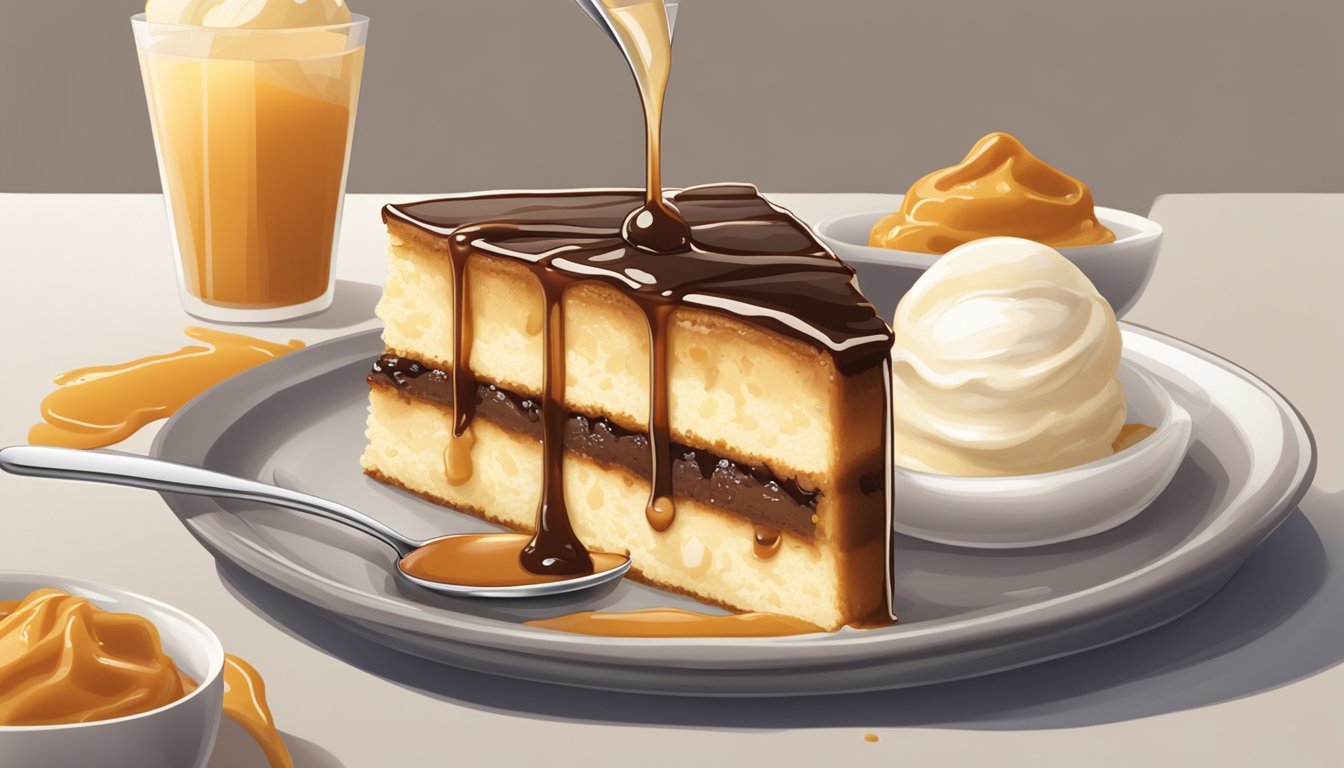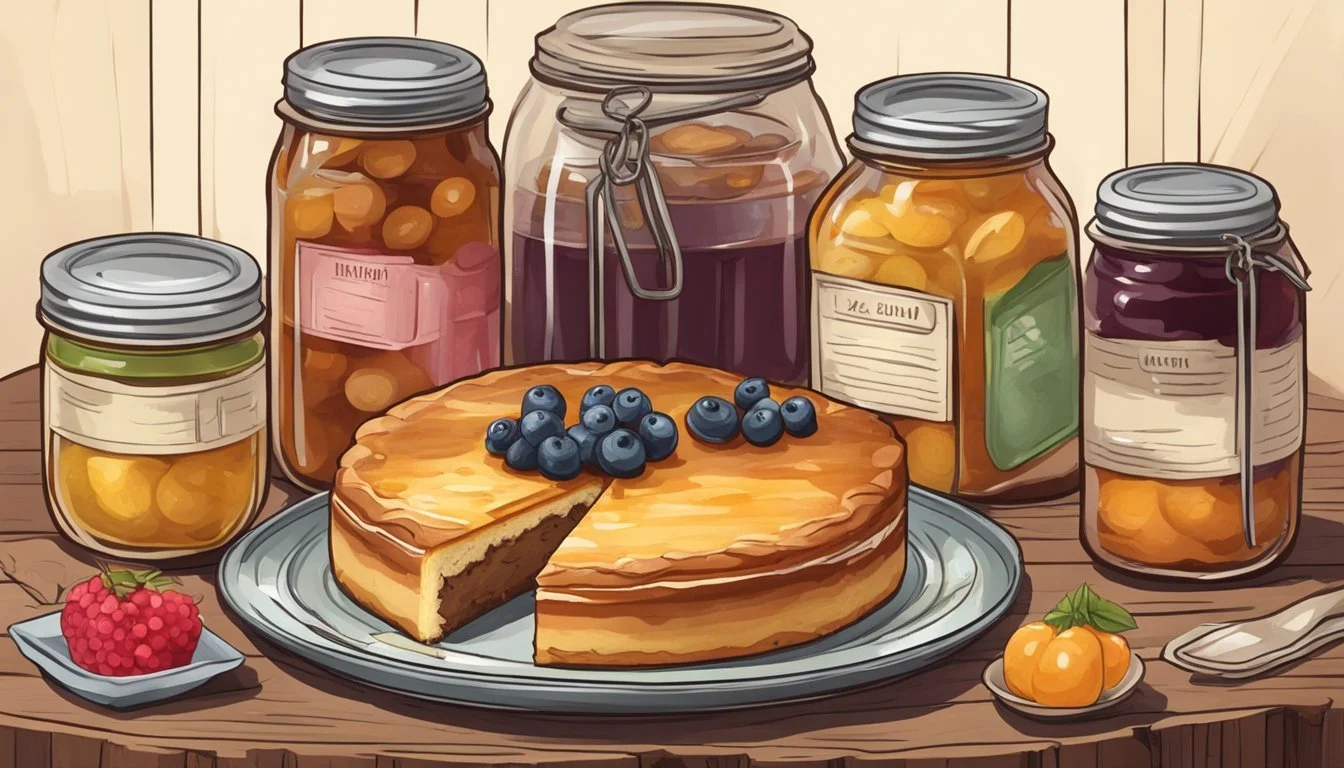How do you eat an upside-down cake?
A Guide to Enjoying this Sweet Inversion
Upside-down cake is a classic dessert that is both visually appealing and deliciously satisfying. The cake is known for its topping of caramelized fruit, which is baked at the bottom of the pan and then flipped over to reveal a vibrant and colorful presentation. Upside-down cakes (how long do cakes last?) are most commonly associated with pineapple and cherries (how long do cherries last?), featuring caramelized pineapple rings and bright red cherries that become the focal point once inverted. The beauty of upside-down cakes lies in their versatility; they can be adapted to a variety of fruits, creating a multitude of flavor combinations.
One may wonder about the best way to indulge in this delectable treat. Eating an upside-down cake is straightforward – it is served upside down, with the fruit on top, after being inverted from the baking pan. Typically presented as a centerpiece during gatherings, it's sliced like any other cake and enjoyed by the slice. Each portion rewards the palate with a blend of moist cake and sweet, syrupy fruit topping. Whether served warm with a scoop of ice cream or enjoyed at room temperature, an upside-down cake offers a delightful experience in each bite.
What Is an Upside-Down Cake?
An upside-down cake is a dessert baked with a layer of sweetened fruit at the bottom of the pan, which becomes the top once the cake is inverted after baking. Traditionally recognized for its caramelized fruit topping, this dessert delivers a harmonious balance of moist cake and flavorful fruit.
History and Origin
Upside-down cakes have a storied history that dates back to the Middle Ages when they were initially cooked in cast iron skillets over an open fire. The method of creating the cake "upside-down" is a nod to the old practices where cakes were often cooked with fruit at the bottom to preserve and caramelize it during the baking process. With the advent of canned pineapples by Dole in the early 20th century, the pineapple upside-down cake became an American classic, cementing its status as a beloved dessert across the country.
Characteristic Features
Characteristic features of upside-down cakes include:
Toppings: Fruit such as pineapples, cherries, or apples, often arranged in a pattern and cooked beneath the batter.
Caramelization: Sugar and butter melt together with the fruit, creating a caramelized coating when the cake is inverted.
Texture: The cakes tend to be moist and buttery, ensuring a tender crumb that complements the soft, caramelized fruit topping.
Flavor: Various fruits can be incorporated, leading to a diverse range of flavors from tangy to sweet.
Selecting Ingredients for the Perfect Upside-Down Cake
Selecting superior ingredients is crucial for creating a delectable upside-down cake. Each ingredient serves a specific purpose, from enhancing flavor to contributing to the cake's structure and texture.
Choosing the Right Fruits
For a classic pineapple upside-down cake, opting for canned pineapple rings allows for a consistent shape and size, which is crucial for presentation. The pineapple juice from the can may also be utilized in the batter to infuse extra flavor. However, using fresh pineapple can elevate the taste if one prefers more natural sweetness. Maraschino cherries are traditionally used for their vibrant color and sweet taste, but one can also consider using fresh cherries or even slices of apples for a twist on the classic.
Best Sugars for Caramelization
Brown sugar is the gold standard for the caramelized topping due to its rich molasses flavor, which complements the fruit. For a different flavor profile, one might experiment with darker sugars like muscovado. The use of butter, preferably unsalted, is also critical in achieving a smooth, rich caramel sauce. A pinch of salt can be added to balance sweetness.
Flour Types and Their Impact
All-purpose flour is typically the best choice for upside-down cakes as it provides the necessary structure without making the cake too dense. If a lighter, more moist cake is desired, cake flour can be used for its finer texture and lower protein content.
The Role of Eggs and Dairy
Eggs are the binding agent in the cake, with the yolks contributing to richness and the whites providing leavening and structure. Sour cream or milk can be used in the batter to enhance moisture and create a tender crumb. The addition of vanilla extract contributes a subtle but essential flavor background to the cake.
Step-by-Step Baking Guide
Upside-down cakes are a classic dessert where the cake is baked with the toppings at the bottom and then inverted after baking. This guide will walk you through preparing a delicious upside-down cake with a rich topping, fluffy batter, and the perfect baking technique that ensures a moist crumb and a beautifully caramelized top.
Preparing the Topping
To start, gather your chosen fruits (traditionally pineapple), melted butter, white sugar, and vanilla. In an ungreased cake pan at least 2 inches deep, whisk together the melted butter with sugar and vanilla. For added flavor, a sprinkle of cinnamon can enhance the taste. Arrange the fruit slices neatly over the butter-sugar mixture to create a decorative pattern that will eventually be the top of the cake.
Mixing the Batter
In a separate bowl, sift together all-purpose flour, baking powder, and salt. In another bowl, combine egg yolks, oil, and vanilla. Some recipes may call for separated egg whites beaten to soft peaks and folded into the batter. Gradually incorporate the dry ingredients alternating with liquids like milk or pineapple juice to create a smooth and homogeneous batter.
Baking the Cake
Preheat the oven to 350ºF (177ºC). Pour the batter into the baking dish over the arranged fruit and topping. The pan should only be filled to 2/3 to prevent overflow. Place it on the center rack of the oven and bake until a toothpick inserted comes out clean, indicating the cake is done. This usually takes around 45 minutes, but it is advisable to rotate the pan 180 degrees halfway through for even cooking.
Inverting the Cake
Once baked, allow the cake to cool in the pan for a few minutes. Then, place a plate or serving dish over the pan and carefully invert the cake onto the plate. Remove the pan gently to reveal the caramelized fruit topping now on top. If any fruit sticks to the pan, simply reposition it on the cake. Serve the upside-down cake warm or at room temperature.
Innovative Twists on the Classic
Venturing beyond the traditional pineapple upside-down cake, bakers have explored a variety of fruits and presentation methods to refresh this classic dessert. These innovations not only add visual appeal but also introduce new flavor profiles for an enhanced dining experience.
Pineapple Variations
Pineapple upside-down cake remains a cherished dessert, but it can be transformed with a few alterations. For those who favor individual servings, pineapple upside down cupcakes offer a personal touch to this classic treat. Incorporating caramel sauce into the recipe elevates the flavor, while adding tropical fruits such as mangoes or papayas can introduce an exotic twist. Bakers may also choose to add nuts, with pecans being a popular choice for an added crunch.
Alternative Fruit Options
Peaches, nectarines, and apricots make excellent substitutes for pineapple in upside-down cakes, each contributing their unique sweetness and texture. Citrus fruits like oranges or tangerines also offer a zesty variation, catering to those who prefer a tangier dessert. When selecting the fruit, it's important to consider its moisture content and how it will affect the cake's structure.
Creative Presentation Ideas
Dessert presentation can be as creative as the recipe itself. One can serve upside-down cakes in new ways, such as layering sliced fruit intricately on the bottom of the pan for an artistic pattern once flipped. For an elegant dessert, mini upside-down cakes can become a centerpiece at dinner parties, allowing each guest their own share. Additionally, serving the cake with a side of ice cream or a dollop of whipped cream can compliment the flavors and enhance the overall dessert experience.
Serving and Pairing Suggestions
Upside-down cakes, with their caramelized fruit topping, offer a versatility that allows them to be paired with various accompaniments and beverages to elevate the eating experience.
Ideal Accompaniments
When serving an upside-down cake, one should consider complementing its rich flavor and moist texture with simple additions. A scoop of vanilla ice cream is a classic choice that balances the warm cake with a cool and creamy counterpart. Another popular option is dolloping whipped cream on top of each cake slice, adding a light and fluffy element. For those who prefer a tropical twist, a sprinkling of shredded coconut can enhance the cake's sweetness and add a pleasant texture. Including fresh fruits such as additional pineapple or berries provides a refreshing contrast and a vibrant visual appeal when arranged neatly around the cake on a serving platter.
Beverage Pairings
Selecting the right beverage to pair with an upside-down cake can enhance the overall dining experience. When considering beverages, one might opt for a warm cup of coffee or tea, which can provide a comforting and balancing effect to the sweetness of the cake. For a more indulgent treat, consider pairing with a dessert wine, which can complement the caramelized notes of the fruit topping. Whether the preference is for a non-alcoholic drink such as a vanilla flavored latte or for those of age, a sweet wine, the choice of beverage should aim to complement, not overpower, the flavors of the upside-down cake.
Storage and Preservation
Proper storage ensures the pineapple upside-down cake remains fresh and delectable. It involves refrigeration or freezing, depending on how long you need to preserve it.
Refrigeration Guidelines
A pineapple upside-down cake can be kept in the refrigerator for 3-4 days. They should employ toothpicks to prevent saran wrap from sticking to the cake's topping. Here are the steps:
Insert toothpicks at several points across the cake.
Cover the cake with saran wrap, allowing it to rest on the toothpicks.
Place the cake in an airtight container to prevent it from absorbing other odors.
Tips for Freezing
Freezing is the best option for long-term preservation. The cake may be frozen for several months with proper wrapping. Follow these instructions for optimal results:
Cool the cake completely.
Wrap the cake tightly first in saran wrap and then aluminum foil to prevent freezer burn.
Label the airtight container with the current date before placing it into the freezer.
Freezing in this manner maintains the cake's flavor and texture until it is ready to be enjoyed again.
Troubleshooting Common Issues
When baking and serving an upside-down cake, enthusiasts might encounter texture inconsistencies or issues related to the topping. Identifying and addressing these problems ensures the cake is enjoyed as intended.
Cake Texture Problems
Uneven Baking: If the cake layers exhibit uneven baking or browning, one might need to adjust their oven temperature to match the recipe’s exact requirement. It’s crucial to space out pans inside the oven to avoid contact with the walls and to consider using cake strips to ensure even baking.
Sticking to the Pan: A common texture issue is when the cake sticks to the pan, leading to breakage. Generously greasing the pan, laying a line with parchment paper, and allowing the cake to cool for about 10 minutes before removing it can assist in a cleaner release from the pan.
Wet Bottom: If the cake has a wet bottom after baking, it could be due to the topping not caramelizing properly. To prevent this, it's important to cook the topping to the right consistency before layering it in the pan.
Sinking Middle: A cake that has sunk in the middle may have been underbaked or exposed to a draft during baking. Ensuring the cake is fully baked and the oven door remains closed during the baking process can mitigate this issue.
Topping Challenges
Pineapple Upside Down Cake Preservation: To store a pineapple upside down cake while maintaining the integrity of the topping, one should insert several toothpicks over the surface and drape plastic wrap over it without touching the topping. This preserves the aesthetic and texture of the cake's signature feature.
Topping Sticking to the Pan: Ensuring the topping doesn't stick to the pan can be as simple as not allowing the cake to cool completely in the pan. Run a knife around the edges and flip the cake while it's still slightly warm to successfully transfer the cake to a serving plate without losing the toppings sticking to the pan.
By addressing these texture and topping issues, bakers can serve perfect upside-down cakes that look as delightful as they taste.
Recipe Variations and Experiments
When it comes to enjoying upside-down cakes, there are a myriad of variations to accommodate different dietary needs and preferences. Experimentation with ingredients can yield delightful results, from gluten-free and vegan cakes to those made with either boxed mixes or scratch recipes.
Gluten-Free and Vegan Options
For those seeking a gluten-free alternative, replacing all-purpose flour with a gluten-free blend is an effective solution. Gluten-free upside-down cakes can still showcase the traditional caramelized fruit topping commonly found in classic recipes such as the pineapple upside-down cake. Additionally, vegan upside-down cakes can be made by using plant-based substitutes, like flax eggs or commercial egg replacers, along with dairy-free margarine or coconut oil.
Substitution Example:
All-purpose flour → 1:1 Gluten-free flour blend
Eggs → Flax eggs or a commercial egg substitute
Butter → Dairy-free margarine or coconut oil
Using Boxed Mixes vs. Scratch Cake
Using a boxed cake mix can be a quick and convenient starting point for creating an upside-down cake, such as a dump cake or a cobbler variation. A yellow cake mix is often the go-to choice for its mellow flavor that complements a variety of fruits. In contrast, preparing a cake from scratch allows for more control over the ingredients and can lead to a more homemade taste that some prefer.
Boxed Mix Advantages:
Time-saving
Consistent results
Scratch Cake Advantages:
Customizable ingredients
Potential for a more authentic flavor
When utilizing a boxed cake mix, one can still incorporate fruit or additional flavorings to personalize the dessert. However, if one opts to create a cake from scratch, they have the liberty to tweak aspects like sweetness, moisture, and density to suit their taste. By experimenting with these options, one can find the perfect balance for a delightful upside-down cake experience.
Food Culture and Upside-Down Cakes
The cultural significance of upside-down cakes stretches through decades and across continents. They have evolved from classic recipes to encompass various global influences, making them a versatile dessert in different culinary traditions.
Upside-Down Cake in the 1960s
During the 1960s, the upside-down cake became a quintessential American dessert, emblematic of the era's enthusiasm for convenient, yet homey sweets. Pineapple upside-down cake, in particular, soared in popularity, due in part to the accessibility of canned pineapple and the convenience of pre-made cake mixes. It became a staple of home baking and a symbol of domestic hospitality, often featured in social gatherings and family meals.
Global Variations
Upside-down cakes are not exclusive to American culture. Their simplicity has allowed them to take on many forms worldwide, adapting to the available local ingredients and tastes. For instance:
Tarte Tatin: Originating in France during the 1880s, this apple dessert is cooked upside down in a skillet, with the fruit caramelized in butter and sugar before the tart is baked.
Blood Orange Upside Down Cake: A citrusy variation that incorporates blood oranges, offering a vibrant color and a tangy twist to the traditional recipe.
Upside-Down Ginger-Pecan Peach Pie: A Southern-inspired version that combines the flavors of ginger and pecan with peaches, adding a nutty and spicy profile.
These examples illustrate the upside-down cake's versatility and its enduring appeal in different food cultures around the world.
Frequently Asked Questions
In this section, readers will find answers to common queries regarding the preparation and customization of upside-down cakes, which often require specific baking techniques and allow for a variety of toppings and flavorings.
FAQ: Baking Techniques
How does one prevent an upside-down cake from becoming soggy?
To avoid a soggy cake, one must thoroughly drain any canned fruits and pat them dry before adding them to the baking pan. This ensures that excess moisture does not seep into the cake batter.What is the best method for ensuring even caramelization on the topping?
Even caramelization can be achieved by melting butter with sugar in the baking pan and arranging the fruit slices in a consistent pattern. By starting in the center and spiraling out, one ensures an even layer of caramelized topping.
FAQ: Toppings and Flavorings
Can one use different fruits for an upside-down cake?
Absolutely. While pineapple and oranges are popular, one can experiment with apples, pears, or stone fruits like peaches and plums for a twist on the classic upside-down cake.Are there variations in the type of sugar used for the topping?
Brown sugar is often preferred for its deep, molasses-like flavor, but white sugar can also be used. Some recipes may combine both for a balanced sweetness and rich color in the caramel.
Conclusion
Eating an upside-down cake provides a delightful experience that is both visually appealing and palate-pleasing. This dessert, recognized for its caramelized fruit topping and tender cake base, offers versatility to both the baker and the diner. One can enjoy it classically, served at room temperature, or elevate the experience by warming it up, pairing it with a scoop of ice cream or a dollop of whipped cream to complement the cake's richness.
Methods to Enjoy an Upside-Down Cake:
Traditionally: Serve as is, at room temperature.
Warm Indulgence: Heat and pair with vanilla ice cream.
Brunch Twist: Transform into French toast for a morning treat.
Innovative Desserts: Repurpose the cake flavor into fudge or other sweets.
Individuals can decide how to consume this dessert based on personal preference or occasion. Whether they prefer a straightforward, classic approach or opt to experiment with turning the upside-down cake into novel confections, the opportunities for enjoyment are numerous. With every bite, the unique combination of the caramelized top layer and the soft cake base is sure to delight any dessert aficionado.








